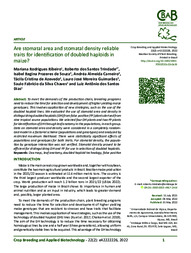Are stomatal area and stomatal density reliable traits for identification of doubled haploids in maize?
Are stomatal area and stomatal density reliable traits for identification of doubled haploids in maize?
Autoria: RIBEIRO, M. R.; TRINDADE, R. dos S.; SOUZA, I. R. P. de; CARNEIRO, A. A.; AZEVEDO, T. C. de; GUIMARAES, L. J. M.; CHAVES, S. F. da S.; DIAS, L. A. dos S.
Resumo: To meet the demands of the production chain, breeding programs need to reduce the time for selection and development of higher yielding maize genotypes. This involves application of new strategies, such as the use of the doubled haploid lines. We evaluated the use of stomatal area and density in distinguishing doubled haploids (DH) from false positive (FP) plants derived from nine tropical source populations. We selected four DH plants and two FP plants for identification of DH through leaf anatomy in the populations, in each group. Data on stomatal area and density were considered in a completely randomized model in a factorial scheme (populations and genotypes) and analyzed by restricted maximum likelihood. There were statistically significant effects of populations and genotypes for both traits. For stomatal density, the population by genotype interaction was not verified. Stomatal density proved to be efficient for distinguishing DH and FP for use in selection of doubled haploids.
Ano de publicação: 2022
Tipo de publicação: Artigo de periódico
Unidade: Embrapa Milho e Sorgo
Palavras-chave: Anatomia Vegetal, Anatomia foliar, Doubled haploids, Duplo haploide, False positive, Falso positivo, Leaf anatomy, Milho, Zea Mays
Observações
1 - Por padrão são exibidas publicações dos últimos 20 anos. Para encontrar publicações mais antigas, configure o filtro ano de publicação, colocando o ano a partir do qual você deseja encontrar publicações. O filtro está na coluna da esquerda na busca acima.
2 - Para ler algumas publicações da Embrapa (apenas as que estão em formato ePub), é necessário ter, no celular ou computador, um desses softwares gratuitos. Sistemas Android: Google Play Livros; IOS: iBooks; Windows e Linux: software Calibre.
Acesse outras publicações
Acesse a Base de Dados da Pesquisa Agropecuária (BDPA) para consultar o acervo completo das bibliotecas da Embrapa.

